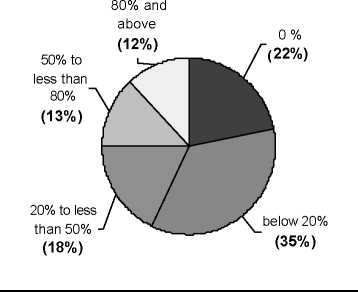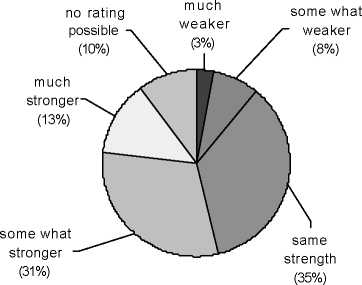Enterprise performance
The performance level of the network partners is a central factor in network success.
Indicators for the performance of enterprises active in a particular network were compiled
from figures on their internal R&D, innovation activities of the last two years, share of
personnel involved in R&D (Figure 1) and assessment of current market position (Figure 2).
Comparing these results of the questionnaire with results of the new federal states overall, it
appears that according to R&D-capacities, innovative activities and competitiveness the
enterprises involved in InnoRegio have obviously a performance above-average.
Nevertheless, these results are probably not unrealistic, as the enterprises were a selection
that have already demonstrated their readiness to innovate by taking part in InnoRegio.
According to the criteria “above-average innovation activities” (20% and more of personnel
assigned to R&D) and “better performance than the competition”, around one-fifth of the
participating enterprises can be categorized as high-performing in all networks. Seven have
a significantly higher share of high-performing enterprises (30% and more), another seven
have an average share, and nine a significantly smaller share (10% and less).
Figure 1
Research and development
of the companies in 2001
Figure 2
Rating of the current market position
of the companies 2001
Companies with share of ...
of personnel involved in R&D from
total number of employees

Source: DIW Berlin and partners, questionnaire
rom summer 2001.
DIW Berlin 2002
Companies rate themselves as ...
when compared to their competitors

Source: DIW Berlin and partners, questionnaire
from summer 2001.
DIW Berlin 2002
Along with the share of high-performing enterprises, the degree of homogeneity probably
influence enterprises’ performance. Uniformly high performance of participating enterprises -
which is currently the case for 12 networks - tends to be advantageous; whereas a more
heterogeneous structure - which is the case for the other nine networks - could potentially
cause problems for network cohesiveness.
More intriguing information
1. The name is absent2. A Dynamic Model of Conflict and Cooperation
3. Uncertain Productivity Growth and the Choice between FDI and Export
4. The name is absent
5. Human Rights Violations by the Executive: Complicity of the Judiciary in Cameroon?
6. The quick and the dead: when reaction beats intention
7. Aktive Klienten - Aktive Politik? (Wie) Läßt sich dauerhafte Unabhängigkeit von Sozialhilfe erreichen? Ein Literaturbericht
8. The name is absent
9. The name is absent
10. The name is absent